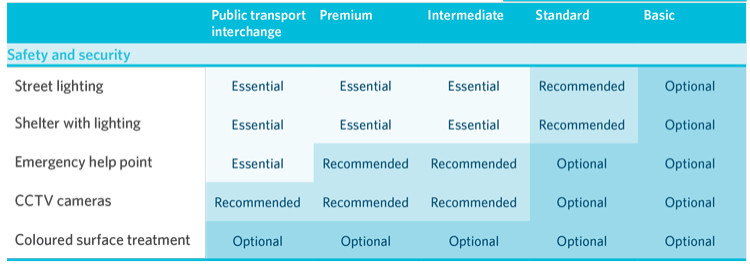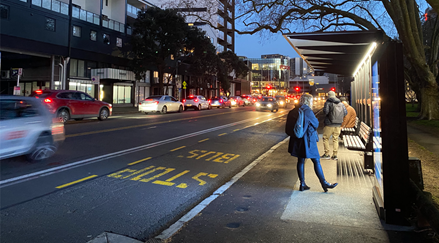How components of bus stops can support safety and security. Lighting plays in important role at bus stops in supporting perceptions of safety and security for customers, enhancing journeys and enabling drivers to see waiting customers.
The table below summarises signs and markings corresponding to each type of bus stop classification and whether the component is essential, recommended or optional.
Where items marked essential are not legislative requirements, departures should be approved by the relevant road controlling authority and public transport authority.
Table: Summary of safety and security components by bus stop classification

Download safety, security and lighting summary table [PDF, 215 KB]
Bus stop components provide an important role in perceptions of personal safety. The main safety and security considerations are as follows.
[1] LGBTQIA+ stands for lesbian, gay, bisexual, transgender, queer (or questioning), intersex, and asexual with the plus (+) sign representing other gender identities and sexual orientations (such as gender-fluid, pansexual and non-binary).
For more information, see:
To mitigate safety issues for all road users, including cyclists and turning traffic, undertake visibility assessments in accordance with:
Lighting at bus stops:
The bus stop and the walk up to it should be well lit at night. The extent that this should be included as part of any bus stop installation or improvement depends on the specific site requirements. Where street lighting is inadequate, independent lighting should be installed, which could be solar powered and mounted on the bus stop pole.
For further guidance on the standards for pedestrian and vehicle lighting levels, see:
Lighting for Roads and Public Spaces (AS/NZS 1158.3.1:2020) (external link)
Connections to the local electricity network can often be difficult or costly. Ideally, each bus shelter should have its own source of illumination. In many instances, good quality solar powered lighting may make the most sense to install from practical and cost perspectives (see the figure below).

Bus stop shelter with lighting. (Credit: Elisa Hardijanto)